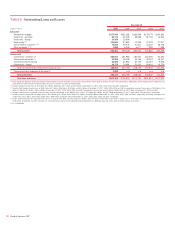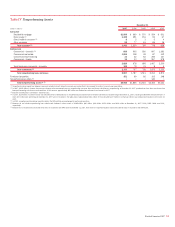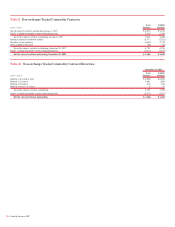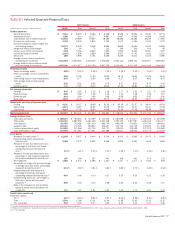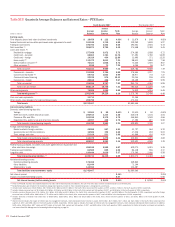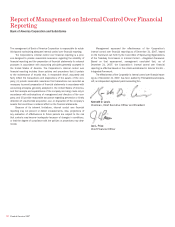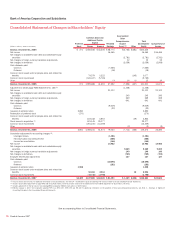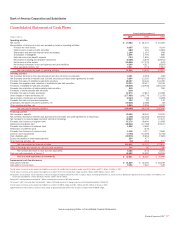Bank of America 2007 Annual Report Download - page 112
Download and view the complete annual report
Please find page 112 of the 2007 Bank of America annual report below. You can navigate through the pages in the report by either clicking on the pages listed below, or by using the keyword search tool below to find specific information within the annual report.Glossary
Assets in Custody – Consist largely of custodial and non-discretionary trust
assets administered for customers excluding brokerage assets. Trust
assets encompass a broad range of asset types including real estate,
private company ownership interest, personal property and investments.
Assets Under Management (AUM) – The total market value of assets under
the investment advisory and discretion of Global Wealth and Investment
Management which generate asset management fees based on a percent-
age of the assets’ market value. AUM reflects assets that are generally
managed for institutional, high net-worth and retail clients and are dis-
tributed through various investment products including mutual funds, other
commingled vehicles and separate accounts.
Bridge Loan – A loan or security which is expected to be replaced by
permanent financing (debt or equity securities, loan syndication or asset
sales) prior to the maturity date of the loan. Bridge loans may include an
unfunded commitment, as well as funded amounts, and are generally
expected to be retired in one year or less.
CDOs-Squared – A type of CDO where the underlying collateralizing secu-
rities include tranches of other CDOs.
Client Brokerage Assets – Include client assets which are held in brokerage
accounts. This includes non-discretionary brokerage and fee-based assets
which generate brokerage income and asset management fee revenue.
Committed Credit Exposure – Committed credit exposure includes any
funded portion of a facility plus the unfunded portion of a facility on which
the Corporation is legally bound to advance funds during a specified period
under prescribed conditions.
Core Net Interest Income –Managed Basis – Net interest income on a fully
taxable-equivalent basis excluding the impact of market-based activities
and certain securitizations.
Credit Default Swaps (CDS) – A derivative contract that provides protection
against the deterioration of credit quality and would allow one party to
receive payment in the event of default by a third party under a borrowing
arrangement.
Derivative – A contract or agreement whose value is derived from changes
in an underlying index such as interest rates, foreign exchange rates or
prices of securities. Derivatives utilized by the Corporation include swaps,
financial futures and forward settlement contracts, and option contracts.
Excess Servicing Income – For certain assets that have been securitized,
interest income, fee revenue and recoveries in excess of interest paid to
the investors, gross credit losses and other trust expenses related to the
securitized receivables are all reclassified into excess servicing income,
which is a component of card income. Excess servicing income also
includes the changes in fair value of the Corporation’s card related
retained interests.
Interest-only (IO) Strip – A residual interest in a securitization trust repre-
senting the right to receive future net cash flows from securitized assets
after payments to third party investors and net credit losses. These arise
when assets are transferred to a special purpose entity as part of an
asset securitization transaction qualifying for sale treatment under GAAP.
Letter of Credit – A document issued by the Corporation on behalf of a
customer to a third party promising to pay that third party upon pre-
sentation of specified documents. A letter of credit effectively substitutes
the Corporation’s credit for that of the Corporation’s customer.
Managed Basis – Managed basis assumes that securitized loans were not
sold and presents earnings on these loans in a manner similar to the way
loans that have not been sold (i.e., held loans) are presented. Noninterest
income, both on a held and managed basis, also includes the impact of
adjustments to the interest-only strip that are recorded in card income.
Managed Net Losses – Represents net charge-offs on held loans combined
with realized credit losses associated with the securitized loan portfolio.
Mortgage Servicing Right (MSR) – The right to service a mortgage loan
when the underlying loan is sold or securitized. Servicing includes collec-
tions for principal, interest and escrow payments from borrowers and
accounting for and remitting principal and interest payments to investors.
Net Interest Yield – Net interest income divided by average total interest-
earning assets.
Operating Basis – A basis of presentation not defined by GAAP that
excludes merger and restructuring charges.
Qualified Special Purpose Entity (QSPE) – A special purpose entity whose
activities are strictly limited to holding and servicing financial assets and
meet the requirements set forth in SFAS 140. A qualified special purpose
entity is generally not required to be consolidated by any party.
Return on Average Common Shareholders’ Equity (ROE) – Measures the
earnings contribution of a unit as a percentage of the shareholders’ equity
allocated to that unit.
Return on Average Tangible Shareholders’ Equity (ROTE) – Measures the
earnings contribution of a unit as a percentage of the shareholders’ equity
allocated to that unit reduced by allocated goodwill.
Securitize / Securitization – A process by which financial assets are sold to
a special purpose entity, which then issues securities collateralized by
those underlying assets, and the return on the securities issued is based
on the principal and interest cash flow of the underlying assets.
Structured Investment Vehicle (SIV) – An entity that issues short duration
debt and uses the proceeds from the issuance to purchase longer-term
fixed income securities.
Unrecognized Tax Benefit (UTB) – The difference between the benefit
recognized for a tax position in accordance with FIN 48, which is measured
as the largest dollar amount of that position that is more-likely-than-not to
be sustained upon settlement, and the tax benefit claimed on a tax return.
Value-at-Risk (VAR) – A VAR model estimates a range of hypothetical
scenarios to calculate a potential loss which is not expected to be
exceeded with a specified confidence level. VAR is a key statistic used to
measure and manage market risk.
Variable Interest Entities (VIE) – A term defined by FIN 46R for an entity
whose equity investors do not have a controlling financial interest. The
entity may not have sufficient equity at risk to finance its activities without
additional subordinated financial support from third parties. The equity
investors may lack the ability to make significant decisions about the enti-
ty’s activities, or they may not absorb the losses or receive the residual
returns generated by the assets and other contractual arrangements of the
VIE. The entity that will absorb a majority of expected variability (the sum
of the absolute values of the expected losses and expected residual
returns) consolidates the VIE and is referred to as the primary beneficiary.
110
Bank of America 2007


